Dear Imaging & CAD/CAM Insider,
Are virtual biopsies the key to earlier and more accurate detection of oral cancers?
A novel optical imaging technique known as harmonic generation microscopy overcomes many of the limitations of other diagnostic techniques to yield high-resolution images of morphological changes in the oral mucosa, according to a presentation at the International Association for Dental Research (IADR) meeting last week.
Read more about the unique capabilities of harmonic generation microscopy -- and efforts to develop this noninvasive technique for use in a clinical environment -- in our latest Imaging & CAD/CAM Insider Exclusive.
In other imaging research presented at the IADR meeting:
- Just as dentistry is beginning to get comfortable with cone-beam CT -- and more aware of the ionizing radiation risks it poses if not used properly -- another well-established diagnostic technology appears headed for the dental operatory: magnetic resonance imaging.
- Optical coherence tomography shows excellent predictive value for detecting and monitoring caries beneath sealants and composite restorations, especially when combined with visual examination, according to researchers from the Beckman Laser Institute.
- And three papers presented at the IADR meeting lend further support to the efficacy of the Canary photothermal imaging system for caries detection and for monitoring enamel demineralization and remineralization.
In other clinical news in the Imaging & CAD/CAM Community, with concerns about medical radiographic exposure on the rise, uncertainty surrounds the need for lateral cephalometric radiographs in orthodontic treatment planning, according to a new study in the American Journal of Orthodontics & Dentofacial Orthopedics.
Meanwhile, major shifts are occurring in the digital impressioning business that are expected to make dental CAD/CAM more attractive and affordable for dental practitioners -- and improve the quality of their restorations in the process. Click here to read more.
In a related development, an effort to standardize dental CAD/CAM systems and software and help grow the CAD/CAM market in the process, 3M, Straumann, and Dental Wings this week unveiled a new collaboration at the International Dental Show in Germany.
On the technology front, an interactive learning tool developed by researchers at the University of Queensland to enhance the learning of oral radiographic anatomy and interpretation received a warm welcome from dental students at the school who got to test-drive it.
Finally, diffuse reflectance spectroscopy is showing promise as a feedback mechanism to prevent iatrogenic nerve damage during oral and maxillofacial laser surgery, according to a recent study in the Journal of Translational Medicine.



















